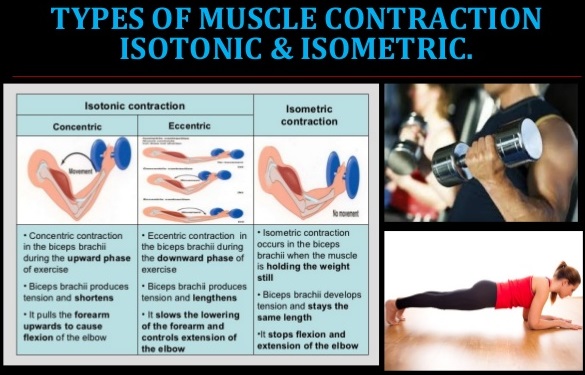Learninsta presents the core concepts of Biology with high-quality research papers and topical review articles.
Types of Skeletal Muscle Contraction
There are two primary types of muscle contractions. They are isotonic contraction and isometric contraction. The types of contractions depend on the changes in the length and tension of the muscle fibres at the time of its contraction.
Isotonic contraction (iso – same, tonweight/resistance) In isotonic contraction the length of the muscle changes but the tension remains constant. Here, the force produced is unchanged. Example: lifting dumb bells and weightlifting. Isometric contraction (iso – same, metric – distance)
In isometric contraction the length of the muscle does not change but the tension of the muscle changes. Here, the force produced is changed. Example: pushing against a wall, holding a heavy bag.
Types of Skeletal Muscle Fibres
The muscle fibres can be classified on the basis of their rate of shortening, either fast or slow and the way in which they produce the ATP needed for contraction, either oxidative or glycolytic. Fibres containing myosin with high ATPase activity are classified as fast fibres and with lower ATPase activity are classified as slow fibres.
Fibres that contain numerous mitochondria and have a high capacity for oxidative phosphorylation are classified as oxidative fibres. Such fibres depend on blood flow to deliver oxygen and nutrients to the muscles. The oxidative fibres are termed as red muscle fibres.
Fibres that contain few mitochondria but possess a high concentration of glycolytic enzymes and large stores of glycogen are called glycolytic fibres. The lack of myoglobin gives pale colour to the fibres, so they are termed as white muscle fibres.
Skeletal muscle fibres are further classified into three types based on the above classification. They are slow – oxidative fibres, fast – oxidative fibres and fast – glycolytic fibres.
1. Slow – Oxidative Fibres
Have low rates of myosin ATP hydrolysis but have the ability to make large amounts of ATP. These fibres are used for prolonged, regular activity such as long distance swimming. Long – distance runners have a high proportion of these fibres in their leg muscles.
2. Fast – Oxidative Fibres
Have high myosin ATPase activity and can make large amounts of ATP. They are particularly suited for rapid actions.
3. Fast – Glycolytic Fibres
Have myosin ATPase activity but cannot make as much ATP as oxidative fires, because their source of ATP is glycolysis. These fibres are best suited for rapid, intense actions, such as short sprint at maximum speed.
Isometric:
A muscular contraction in which the length of the muscle does not change.
Isotonic:
A muscular contraction in which the length of the muscle changes.
Eccentric:
An isotonic contraction where the muscle lengthens.
Concentric:
An isotonic contraction where the muscle shortens. Types of Contractions. There are three types of muscle contraction: concentric, isometric, and eccentric.
Isometric:
Of or involving muscular contraction against resistance in which the length of the muscle remains the same.
Isotonic:
Of or involving muscular contraction against resistance in which the length of the muscle changes.
The process of muscular contraction occurs over a number of key steps, including: Depolarisation and calcium ion release.
Actin and myosin cross-bridge formation.
Sliding mechanism of actin and myosin filaments.
Sarcomere shortening (muscle contraction)
Isotonic contractions – These occur when a muscle contracts and changes length and there are two types:
Isotonic concentric contraction – This involves the muscle shortening.
Isotonic eccentric contraction – This involves the muscle lengthening whilst it is under tension.
The first step in the process of contraction is for Ca++ to bind to troponin so that tropomyosin can slide away from the binding sites on the actin strands. This allows the myosin heads to bind to these exposed binding sites and form cross-bridges.
Abstract. Skeletal muscle is one of the most dynamic and plastic tissues of the human body. In humans, skeletal muscle comprises approximately 40% of total body weight and contains 50-75% of all body proteins.
Skeletal muscles only pull in one direction. For this reason they always come in pairs. When one muscle in a pair contracts, to bend a joint for example, its counterpart then contracts and pulls in the opposite direction to straighten the joint out again.
This is a table of skeletal muscles of the human anatomy. There are around 650 skeletal muscles within the typical human body. Almost every muscle constitutes one part of a pair of identical bilateral muscles, found on both sides, resulting in approximately 320 pairs of muscles, as presented in this article.
